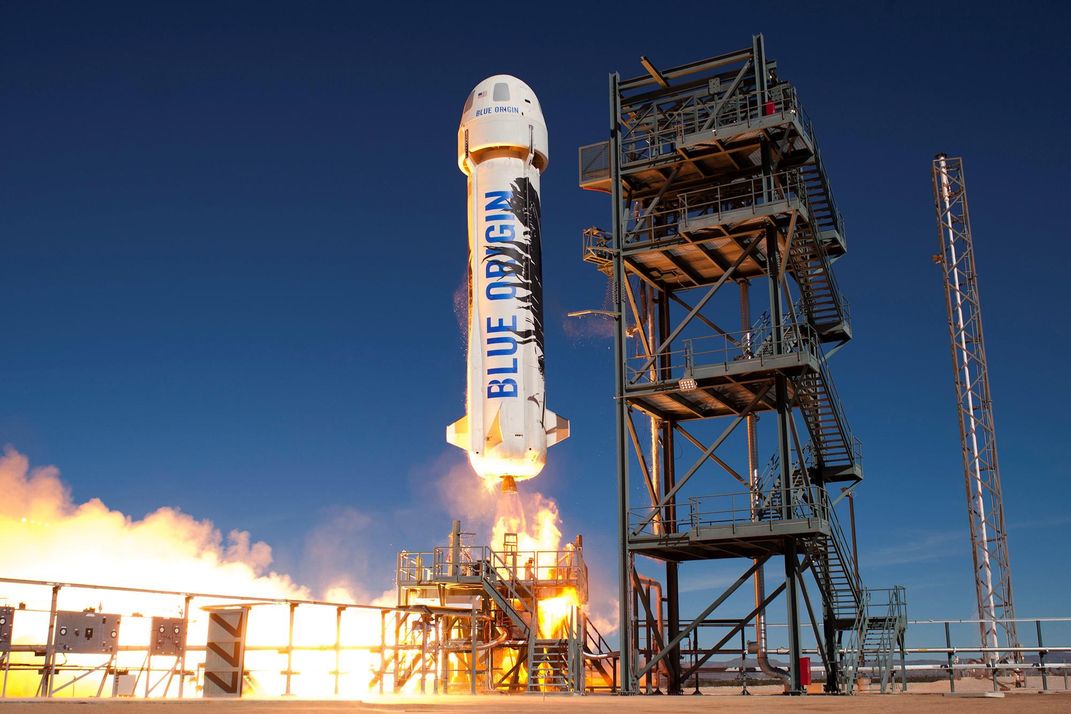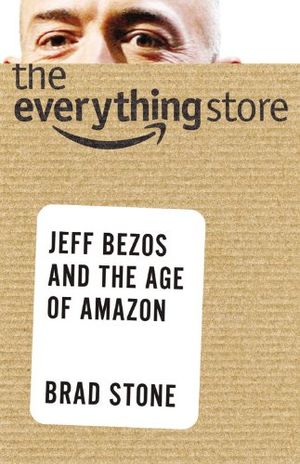Is Jeff Bezos’ Blue Origin the Future of Space Exploration?
No one had ever launched, landed and relaunched a rocket into space until the company’s historic achievement
/https://tf-cmsv2-smithsonianmag-media.s3.amazonaws.com/filer/71/df/71dfeb93-6318-48c0-bb05-e6d45ea97db6/dec2016_d13_ingenuity-wr-v2.jpg)
In the history of space travel, technology that changes everything has rarely looked as down-to-earth as the four spindly struts at the bottom of Jeff Bezos’ first rocket. Late last year, they allowed it to do something that no rocket had ever done before: fly to space, then fly back to Earth and settle down, upright, as if ready to fly again. Two months later, the rocket did just that, blasting off and landing a second time. Later it did it again. And again. And again.
“One day,” Bezos says, “all rockets will have landing gear.”
He is sitting on the expansive manufacturing floor at the headquarters of Blue Origin, the spaceflight company he quietly founded 16 years ago, in an old Boeing plant south of Seattle. Behind him is the rocket booster assembly area. In front of him, workers are putting together crew capsules with cartoonishly large windows.
The new-economy pioneer who founded Amazon.com and revolutionized retail by making it effortless to shop, Bezos expects to revolutionize space travel with an equally simple notion: If we’re going to come and go to space, our spaceships will have to come and go, too. As he puts it, “Launch, land, repeat.”
“When you look at expendable rockets today, the cost of propellant is only about 1 percent of the cost of the mission,” he says. “The big costs come from throwing that aerospace-grade hardware away. With reusability, in theory, you can see a path to lowering the cost of access to space by a factor of 100.”
In other words, a launch that today costs $60 million or $100 million would cost just $1 million. “That’s gigantic,” Bezos says. “It would change everything.”
And much as Amazon isn’t choosy about what you can buy—in fact, it wants you to be able to buy anything and everything—Blue Origin is rather agnostic about what people end up doing in space. The company’s goal is to get them there. “Personally, I would love to go to space,” Bezos says. “But it’s not the thing that’s most important to me. I believe that we are sitting on the edge of a golden age of space exploration. Right on the edge. The thing that I would be most proud of, when I’m 80 years old, is if Blue Origin can lower the cost of access to space by such a large amount that there can be a dynamic, entrepreneurial explosion in space—just as we’ve seen over the last 20 years on the internet.”
Bezos was only 5 years old in 1969 when Neil Armstrong and Buzz Aldrin first stepped on the Moon—an achievement that he says inspires his work to this day. The problem, as he sees it, is that not enough has happened since then: Fewer than 600 people have made it to outer space. “If you look at the progress we’ve made over the last five decades,” he says, “it hasn’t been that much.”
Now 52 years old, Bezos has reportedly put $500 million of his own money into Blue Origin to change that. His first operational rocket, New Shepard, which Bezos named for America’s first astronaut, Alan Shepard, was designed fresh, down to the steerable tail fins at its base. It flies into space nose-first and back to Earth tail-first, with a ring near the top of the rocket’s first stage that acts as a circular fin to stabilize the rocket as it descends at the speed of sound. The crew capsule has the largest windows ever on a spacecraft—single, multilayered acrylic panes that are 3.5 feet tall and 2 feet wide, no minor detail when Bezos’ vision for commercializing Blue Origin, especially in the early going, is ferrying tourists to suborbital space. The engine—also developed from scratch—provides 110,000 pounds of thrust on launch, turns off, and can be restarted in the last 30 seconds of flight and throttled down to 20,000 pounds of thrust, enabling the spacecraft to settle gently on its landing gear.
And Bezos’ rocket works: In less than a year, between November 2015 and early October, Blue Origin launched the same New Shepard rocket to the edge of space five times and landed it safely. No other rocket has ever been used even twice.
At the moment, Blue Origin has just one major customer—United Launch Alliance, a launch contractor for clients like NASA and the U.S. military—which is in the market for Blue Origin’s next-generation rocket engines. But Bezos is thinking long term, and in this sense, too, his strategy has something in common with Amazon, which started 22 years ago as an online bookseller. Bezos isn’t building a rocket business for profitability in 2020. He’s aiming for market dominance in 2040.
This past September, Blue Origin announced its second rocket: New Glenn, a huge leap in scale, almost as tall as the legendary Saturn V Moon rocket, with 35 times the lifting power of New Shepard. New Glenn is designed to go into Earth orbit and then to re-enter Earth’s atmosphere and land tail-first despite its enormous size. Rockets the scale of New Glenn and larger could one day loft 100 or more passengers, Bezos suggests. And these first two rockets, he says, are Model T’s: Even as they are being built and tested, their more capable successors are in the planning and design stages.
In the aerospace world, there is plenty of skepticism of Bezos and Blue Origin—and of fellow commercial spaceflight entrepreneurs like Elon Musk and his company SpaceX. Musk and Bezos have pushed their companies along different paths. Bezos is focused on reusability, but hasn’t yet put a rocket into orbit. Musk is focused on building an operational system—SpaceX rockets routinely service the International Space Station—but is still working toward reusability to reduce costs.
Aerospace insiders aren’t skeptical of the entrepreneurs’ ability to master complex technology, just of the need for it. Bezos has predicted 50 to 100 launches a year for Blue Origin alone in the not-too-distant future. The skeptics ask: Where will the demand come from?
Here’s where Bezos’ track record is persuasive. The internet’s ever-increasing speed, computing power and bandwidth combined to create whole categories of business that no one had thought of. Bezos is confident that once space is cheap and safe, entrepreneurs will rush to create new businesses that have not even been imagined.
Back in 1982, Bezos was the valedictorian of Miami’s Palmetto Senior High School. In his graduation speech, he sketched a vision of millions of people living in space, and he told the Miami Herald he imagined a time when the Earth would become a kind of park for human recreation. “The whole idea,” he said then, “is to preserve the Earth.”
That vision seemed fanciful three decades ago. But when Bezos talks about the future today, he sounds remarkably like his 18-year-old self. He still envisions “millions of people living and working in space, and exploring the entire solar system.” Because of the abundance of natural resources in asteroids and comets, and the ease of generating power in orbit, he believes most heavy industry will migrate to space, leaving Earth protected. “You’ll send the finished products down to Earth,” he says. “And Earth will get zoned residential and light industrial.”
Bezos thinks creating a real space age, and a real space economy, will unleash a new era of creativity and ingenuity. “I don’t want to live in a civilization of stasis,” he says. “I want to live in a civilization of invention, and growth, and incredible new things. And I’m very confident it’s the only way—you have to go to space.”


The Everything Store: Jeff Bezos and the Age of Amazon

